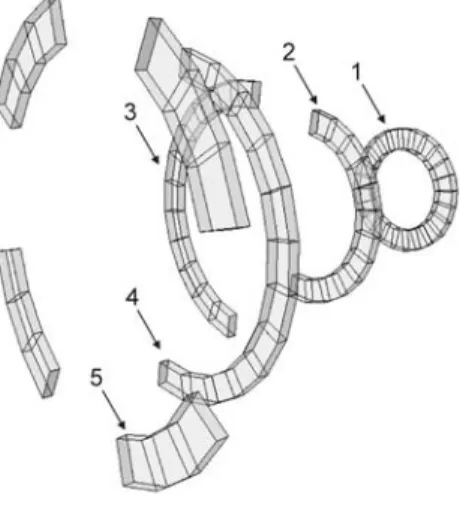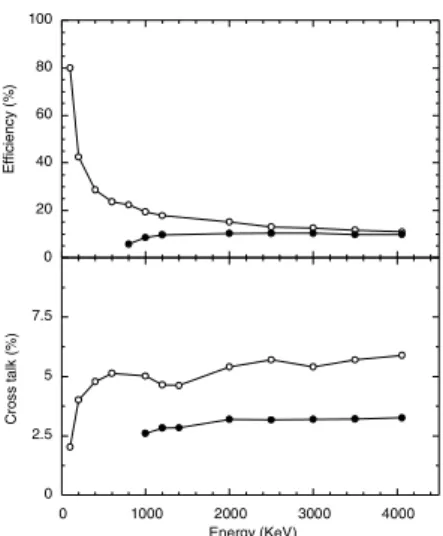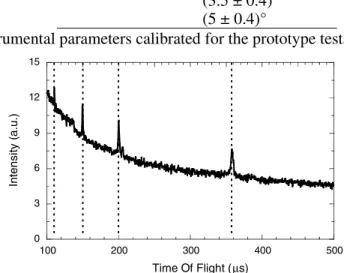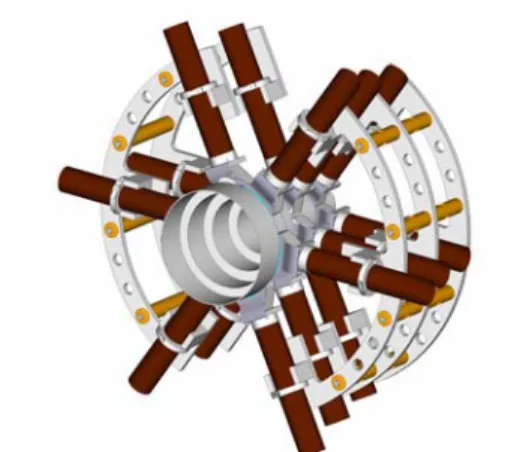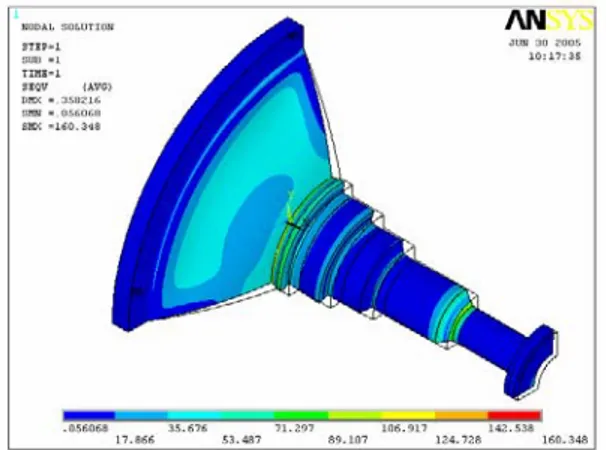VLAD for epithermal neutron scattering experiments at large
energy transfers
M. Tardocchi1, G. Gorini1, E. Perelli-Cippo1, C. Andreani2, S. Imberti2, A. Pietropaolo2, R. Senesi2, N. R. Rhodes3, E. M. Schooneveld3
1
CNR-INFM and Università degli Studi di Milano-Bicocca, Dipartimento di Fisica “G. Occhialini”, Milano, Italy
2
Università degli Studi di Roma “Tor Vergata”, Dipartimento di Fisica and CNR-INFM, Roma, Italy
3
Rutherford Appleton Laboratory, ISIS Facility, Chilton, UK [email protected]
Abstract. The Very Low Angle Detector (VLAD) bank will extend the kinematical region
covered by today’s epithermal neutron scattering experiments to low momentum transfer (< 10 Å-1
) together with large energy transfer > 1 eV. Such kinematical region is so far unexplored and will allow for new experimental studies in condensed matter systems. VLAD is at present being commissioned on the VESUVIO spectrometer at the ISIS pulsed neutron source. It consists of an array of Resonant Detectors covering the scattering range 1°-4°. In this paper the design of VLAD is presented together with Montecarlo simulations of the detector performances. The results of tests made with prototype VLAD detectors are also presented, confirming the usefulness of the Resonance Detector for measurements at very low scattering angles.
1. Introduction
Neutron scattering experiments with epithermal neutrons allow for studies of condensed matter systems in a unique kinematical range of exchange wave vector (q) and energy transfer (ω). Such measurements are performed on the VESUVIO spectrometer at the ISIS spallation neutron source in UK. VESUVIO [1] is an inverse geometry neutron spectrometer (Fig. 1) where a polychromatic neutron beam emerging from a water moderator is scattered off a sample and detected with neutron detectors. Selection of the final neutron energy via a resonant filter and the time of flight technique are used to reconstruct the full kinematics of the scattering event. At present VESUVIO can detect epithermal neutrons scattered at angles above 20°, which translates into exchange wave vectors and energy transfers of 20 A-1 < q < 200 A-1 and 1 eV< ω < 10 eV, respectively. Experiments in such kinematical range have been performed in the last ten years to successfully investigate condensed matter systems such as hydrogen bond and metal hydrides [2], metals [3], glasses [4] and quantum fluid and solids [5]. Still there is a strong interest into extending the kinematical region to low wave vector transfers (3 A-1 < q < 10 A-1) together with high energy transfers (0.1 eV< ω < 5 eV). This is the
Institute of Physics Publishing Journal of Physics: Conference Series 41 (2006) 451–459
doi:10.1088/1742-6596/41/1/050 EPS Euroconference XIX Nuclear Physics Divisional Conference
451 © 2006 IOP Publishing Ltd
range where the so called High Energy Inelastic Scattering (HINS) regime applies. HINS experiments would make possible a whole new series of experimental investigations such as dispersion relations of magnetic materials [6] and semiconductors [7], high lying molecular vibrations [8], etc …[9]. Extending neutron scattering experiments to the HINS kinematical regime requires the detection of epithermal neutrons in the 1-100 eV energy range at scattering angles as low as 1°-4° [10]. This will be the task performed by the new Very Low Angle Detector (VLAD) bank which presently is being installed on VESUVIO.
Figure 1 Principle of an inverse geometry time of flight spectrometer based on the Resonance Detector. The picture shows the incoming neutron beam (n), the scattered one (n’) and the RD unit
made of an analyser foil viewed by a photon detector.
Neutron detection in VLAD is based on the Resonant Detector (RD) [11] which has been developed in order to improve the detection efficiency of epithermal neutrons at pulsed neutron sources. In the RD approach (see Fig. 1) neutron detection is divided in a two-step process i) resonant neutron capture by an analyzer foil which strongly absorbs scattered neutrons over a narrow energy interval; ii) detection of the prompt γ-ray cascade following the radiative decay of the compound nucleus to the ground state. The energy spectrum of the prompt γ rays depends on the absorbing nucleus, but in general it covers a wide range from tens of keV up to few MeV values. The role of the photon detector is limited to photon counting which is used to tag the arrival time of the absorbed neutron in the analyzer foil. The RD is made of an analyzer foil viewed by a photon detector. Among the RD combinations of analyzer foil and photon detector studied in the last years [12], the choice for VLAD has fallen on the combination of a YAP scintillator together with natural uranium [13]. YAP, which is a short name for Yttrium Aluminum Perovskite (YAlO3) activated with Cerium, offers the advantage of being fast, highly insensitive to neutrons, mechanically and chemically resistant and is available in virtually any size [13]. Natural uranium shows intense (>20000 barn) and narrow (<50 meV) neutron resonance in the 1-100 eV range [14]. This means that good neutron absorption efficiency is reached with foil thickness as low as 25-80 μm which ensures a low self-absorption probability of the emitted gamma rays. Gold foils can alternatively be used when requirements on narrow energy resolution can be relaxed.
VLAD consists of an array of RD units covering the scattering range 1°-4°. This paper summarizes the conceptual design of VLAD together with a discussion of some issues relative to the detector performances, such as gamma detection efficiency and cross talk between channels, which were the subject of Montecarlo simulations. The results of tests made with prototype VLAD detectors will be briefly presented, confirming the usefulness of the RD approach for measurements at scattering angles as low as 2°. Finally the progress of the detector installation will be illustrated.
2. VLAD design
VLAD has been designed to cover with a high efficiency the scattering range 1°-4°. VLAD is an array of annular rings, segmented in a number of planar RD units. A RD unit is made of two YAP crystals
moderator sample analyzer foil θ L1 γ detector collimator γ n n’ L0 452
of trapezoidal shapes, with uranium foils attached on the front side. This geometry is a good choice for matching the circular ring around the vacuum pipe containing the unscattered neutron beam. The light emitted from each RD unit is collected via an aluminum light guide with a standard photomultiplier tube. The design of the detector array geometry has been optimized with the help of Montecarlo simulations [15]. The optimization was a trade off between the need of high efficiency to detect
Figure 2 The telescopic detector configuration selected for VLAD. Five detector arrays (labelled 1 to 5) cover the scattering angular range 1°<2θ<4°. For simplicity only the scintillator crystals are shown. neutrons, i.e. enough crystal thickness to stop the radiative capture γ rays, and undesired features from background components. In particular, two background effects have been studied in detail, namely cross talk among channels and multiple neutron scattering events.
Measurements have shown that a YAP crystal thickness of 6 mm represents a good compromise between efficiency to the prompt photons (signal) and low sensitivity to the environmental gamma background [13]. In Ref. [16] it is shown that a thicker crystal, i.e. higher efficiency, do not improve the signal to background ratio, which is optimized with a lower level threshold at about 600 keV. Few different array geometries have been simulated [17]. The chosen final geometry (see Fig. 2) consists of half rings of detector arranged in a telescopic configuration; the innermost array is a full ring to increase the detection efficiency. The scattering angles that are covered by VLAD range from to 1° to 4°, each with an angular width of about 0.5°. Such configuration provides a reasonable efficiency still keeping cross talk among channels below the 5% level. This is indicated for instance in Fig 3 where the detector efficiency for one channel is shown as a function of the emitted photon energy. One can note that with a lower level threshold at 0.6 MeV a 10 % efficiency is obtained with a cross talk level
0 2.5 5 7.5 0 1000 2000 3000 4000 Energy (KeV) Cr o s s ta lk (%) 20 40 60 80 100 Eff icie n c y ( % ) 0
Figure 3 Simulation of photon detectors events in the detector #2 (top) and in detector #1 (bottom) due to photons generated at the analyzer foil of detector #2, for different values of the initial energy.
Data have been normalized to the total number of photons. Data are shown assuming either no detection threshold (full circles) or a 600 keV lower level threshold (empty circles).
Figure 4 Photograph of the VLAD prototype showing four RD units viewing the scattering sample through an Aluminum vacuum tank. Each RD unit consists of a scintillator whose light is collected via
an aluminum light guide to a PM-tube.
in the neighboring channel at about 3 %. Simulations of the influence of the neutron scattering to the detector response have shown that the dominant contribution comes from neutron backscattering in the YAP crystals. However, this neutron background is spread over a broad energy range and does not contain any spectral feature in the HINS region of interest [15]. This makes it easier to eliminate its contribution in the data analysis.
3. Prototype tests
A prototype VLAD detector with four RD units has been built to test the feasibility of HINS measurements in the severe condition of the VESUVIO beam line [16]. The RD units were installed on an aluminium frame at different angular position, namely 2°, 3.5° and 5°, at the edge of an extended vacuum tank (see Fig. 4); the latter was realised in order to have the scattered neutrons propagating in vacuum up to the VLAD position. A new collimation, made of three cylinders of boron carbide (BC4) with decreasing hole sizes from 26 to 22 mm diameter, was mounted in the incoming neutron pipe. This allowed bringing the neutron beam umbra down to 23 mm at sample position and
45 mm at VLAD position. Tightening the neutron beam is necessary in order to both achieve good angular resolution [10] and avoid the vacuum pipe and the innermost VLAD detectors to be hit by the unscattered neutron beam.
The sample studied was ice Ih. Water (and ice in almost all its forms) is a well known physical system, thus representing a benchmark sample for HINS measurements. In particular, the aim of the measurement was to observe the O-H stretching vibrational band located at an exchange energy of 420 meV [18]. A sample of ice at 270 K was set up in a standard 1 mm thick and 50 mm wide aluminium can. Temperature of the sample was remotely controlled and kept constant within 0.1K.
The physical parameters of the VESUVIO spectrometer and the VLAD detector – namely the incident and final flight paths L0 and L1 and the scattering angle 2θ − have been calibrated using the fitting procedure described in [19] and are shown in table 1.
Parameter Value L0 (11.055 ± 0.2) m L1 (2.013 ± 0.2) m 2θ (2 ± 0.4)° (3.5 ± 0.4)° (5 ± 0.4)°
Table 1: VESUVIO instrumental parameters calibrated for the prototype tests.
0 3 6 9 12 15 100 200 300 400 500 In tensi ty ( a .u. ) Time Of Flight (μs)
Figure 5 Time of flight spectrum from the prototype tests at 2θ=2°. The vertical lines show the position of four elastic scattering peaks.
A time-of-flight spectrum recorded from the ice sample at 2° is shown in Fig. 5. The peaks visible in the spectrum are related to the four uranium neutron absorption resonances between 6.67 and 66.02 eV, and they represent a four times repetition of the vibrational spectrum of ice. The main peaks correspond to the elastic scattering (ħω = 0) while the inelastic scattering lines are located on the left side (i.e. at shorter time) of the elastic peaks. The background in the spectrum has proven to be mainly due to i) neutron scattering in the aluminium can ii) uranium natural radioactivity iii) neutron-induced gammas in the VESUVIO experimental hall. Background from the aluminium can has been subtracted taking as a reference an empty can run. The residual background has been eliminated with a standard procedure used for VESUVIO measurements [16]. A suitable analytical function has been fitted to the background, taking care in excluding the elastic peaks and the peak wings (where the inelastic scattering information is located). We observe that this approach is particularly valid in this case, where we expect the entire vibrational spectrum to be located in small time region near the elastic peaks, at no more than 20 μs apart.
The reduced spectrum has been transformed from time of flight to exchanged energy (ħω) via the equation
[
]
2 0 21
2
r rL
m
E
t t
ω
=
−
−
h
where m is the neutron mass, t
ris the flight time corresponding to the resonance energy E
r. Inparticular, we have focused on the first resonance at 6.67 eV. From the above transformation one can obtain the energy spectrum from ice vibrational states, in form of the so-called dynamic structure factor [20] 2 0 1 1
4
( , )
totk
S q
k
E
π
σ
ω
σ
∂
=
∂Ω∂
where k0 and k1 are the neutron incident and final wave-vectors, respectively, σtot is the total scattering
cross section and
∂
2σ ω
/
∂ ∂
E
1 is the double differential scattering cross-section of the scattering nuclei. The S(q,ω) is the usual representation of the vibrational spectra taken with neutrons.The results of the VLAD prototype measurements on ice [16, 21] are in good agreement with previous results [18] and hence confirming the feasibility of the HINS approach with a physically interesting sample.
Figure 6 Three dimensional CAD drawing of VLAD showing the telescopic vacuum vessel, the detectors (in grey) and the PM-tube (in red). Part of the support structure is not shown. Neutrons are coming from the left of the picture.
4. Detector construction and assembly
Based on the detector array design of Fig. 2 a CAD model of the entire VLAD was made (See Fig. 6). The VLAD is at about 2m from the sample position. The terminal part of the vacuum vessel is of telescopic shape in order not to intercept the neutrons scattered at very low angles. A total of 20 PM-tubes positioned in the radial direction relative to the neutron beam collect the light from the corresponding RD units. Each PM-tube is read individually and the time of flight data from RD units belonging to the same annular ring are summed afterward in the data analysis.
A special effort was spent on the design of the terminal part of the VLAD vacuum vessel. A key feature was to keep the aluminium (anticordal) thickness everywhere down to 2 mm to minimize neutron scattering. To verify the mechanical behaviour of the vacuum vessel at 1 Atm external pressure load, calculations of the stress distribution have been performed using a finite element model. The maximum Von Mises stress (see Fig. 7) was found to be concentrated in correspondence of the mechanical joints, but however well below the allowable range of 166 Pa.
The final assembly of the different VLAD components (vacuum vessel, detectors, analyser foils) has been done during the installation phase on VESUVIO. The VLAD detector is at present being commissioned. A photograph of the terminal part of the VLAD vacuum vessel before installation is shown in Fig. 8. The components forming a single RD unit are shown in Fig. 9. The frame holder of the analyser foil allows one to replace or remove the foil from the detector without having the need of
Figure 7 Results from simulation of Von Mises stress in the VLAD vessel.
Figure 8 Photograph of the terminal part of the VLAD vacuum vessel. Neutrons are coming from the right of the photograph.
Figure 9 Photograph of the components of a RD unit showing the aluminum light guide, the frame holder of the analyzer foil and the two scintillators crystals of trapezoidal shapes.
moving the latter. This is if practical help, specifically in those situations where a measurement without the analyser foil is needed for background subtraction purposes.
5. Conclusions
The design of the Very Low Angle Detector (VLAD) for epithermal neutron scattering experiments at low scattering angles (from 1° to 4°) has been presented. Montecarlo simulations of the detector performances have shown that VLAD meets the requirements in terms of detection efficiency, cross talk and neutron scattering events. The results of tests made with prototype VLAD detectors have confirmed the feasibility of the Resonance Detector approach for measurements at scattering angles as low as 2°. VLAD is presently being commissioned and expected to deliver new science in the coming months.
Acknowledgments
This work was performed with financial support by the European Community-Access to Research Infrastructure action of the Improving Human Potential Program (EU Project HPRI-CT-2001-50020). We acknowledge Consiglio Nazionale delle Ricerche (CNR)-Italy for financial support for the experiments performed at the ISIS pulsed neutron source.
References
[1] R. Senesi, C. Andreani, Z. Bowden, D. Colognesi, E. Degiorgi, A.L. Fielding, J. Mayers, M. Nardone, J. Norris, M. Praitano, N.J. Rhodes, W.G. Stirling, J. Tomkinson, C. Uden, Physica B 276-278, (2000) 200.
[2] P. Postorino, F. Fillaux, J. Mayers, J. Tomkinson, R.S. Holt, J. Chem. Phys. 94 (1992) 4411. [3] E.Balcarand, S.W.Lovesey, J.Phys.Cond.Matter, 5 (1993) 7269.
[4] E.M.A. Gray, M. Kemali, J. Mayers, J. Noreland, J. Alloys Compounds 253 (1997) 291. [5] J. Mayers, T.M. Burke, R.J. Newport, J. Phys.: Condens. Matter 6 (1994) 641.
[6] G.T. Trammel, Phys. Rev 92 (1953) 1387; E. Balcar and S.W. Lovesey, J. Phys. C19 (1986) 4605.
[7] J. F. Cooke and J. A. Blackman Phys. Rev. B 26, 4410 (1982).
[8] C. Andreani, P. Bosi, F. Sacchetti, C.K. Loong, J. Chem. Phys. 83, 750 (1985).
[9] A. D. Taylor, R. Osborn, K.A. McEwen, W.G. Stirling, Z.A. Bowden, W.G. Williams, E. Balcar, S.W. Lovesy, Phys. Rev. Lett. 61 (1988) 1309.
[10] S. Imberti, C. Andreani, V. Garbuio, G. Gorini, A. Pietropaolo, R. Senesi, M. Tardocchi, Nucl. Instr. and Meth. A., 552 (2005) 463.
[11] G. Gorini, E. Perelli-Cippo, M. Tardocchi, C. Andreani, A. D’Angelo, A. Pietropaolo, R. Senesi, S. Imberti, A. Bracco, E. Previtali, G. Pessina, N. J. Rhodes, E. M. Schooneveld, Nucl. Instr. and Meth. A, 529 (2004) 293.
[12] C. Andreani, A. Pietropaolo, R. Senesi, G. Gorini, M. Tardocchi, A. Bracco, N. Rhodes, E. Schooneveld, Nucl. Instr. and Meth. A 481 (2002) 509; C. Andreani, A. D’Angelo, G. Gorini, S. Imberti, A. Pietropaolo, N. J. Rhodes, E. M. Schooneveld, R. Senesi, M. Tardocchi, Appl. Phys. A 78 (2004) 903; M. Tardocchi, C. Arnaboldi, G. Gorini, S. Imberti, G. Pessina, E. Previtali, C. Andreani, A. Pietropaolo, R. Senesi, Physica B, 350 (2004) e853. [13] M. Tardocchi, A. Pietropaolo, R. Senesi, C.Andreani, G.Gorini, N. Rhodes, E. S. Schooneveld,
Review of Scientific Instruments, Vol. 75, (2004) 4880.
[14] A. Pietropaolo, C. Andreani, A. D’Angelo, R. Senesi, G. Gorini, S. Imberti, M. Tardocchi, N. Rhodes, E. S. Schooneveld, Appl. Phys. A 74 [Suppl.] (2002) S189.
[15] “The new Very Low Angle Detector (VLAD) for epithermal neutron sectroscopy”, E. Perelli-Cippo, Ph.D. thesis, Nov. 2005, Università di Milano-Bicocca, Italy.
[16] “The O-H stretching band in ice Ih derived via eV neutron spectroscopy on VESUVIO using the
new Very Low Angle Detector bank”, E. Perelli-Cippo, G. Gorini, M. Tardocchi, C. Andreani, , S. Imberti, A. Pietropaolo, R. Senesi, N. Rhodes, E. M. Schooneveld, submitted to Appl. Phys. A (2005).
[17] E. Perelli-Cippo, G. Gorini, M. Tardocchi, O. Cremonesi, C. Andreani, A. Pietropaolo, R. Senesi, Z. Bowden, N. J. Rhodes and E. M. Schooneveld, IEEE Transactions on Nuclear Science, Vol. 52, n.4, (2005) 1092.
[18] C. Andreani, P. Bosi, F. Sacchetti, C. K. Loong J. Chem. Phys. 83 No.2 (1985) 750
[19] “Deep Inelastic Neutron Scattering from water in the 1-40eV energy range employing the Resonance Detector Spectrometer configuration” A.Pietropaolo, C.Andreani, A.Filabozzi, G.Gorini, S.Nufris, E.Perelli Cippo, N.J. Rhodes E. M. Schooneveld, R. Senesi, M. Tardocchi, submitted to Appl. Phys. A (2005).
[20] S. W. Lovesey, “Theory of Neutron Scattering from Condensed Matter”, Oxford University Press, London, 1987.
[21] C. Andreani, G. Gorini, E. Perelli-Cippo, A. Pietropaolo, N. Rhodes, E. S. Schooneveld, R. Senesi, M. Tardocchi, Applied Physics Letters, 85 (2004) 5454.

